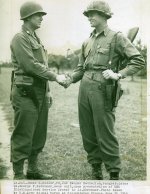There was an interesting photo that sort of featured handguns in today's Washington Post. It was on the obituary page, which I usually read first. The photo accompanied the obituary of George Kerchner, 93, who was in the ranger company that scaled the cliffs during the Normany invasion. The photo was of him being congratulated upon being decorated with the Distinguished Service Cross.
What made the 6x9 photo interesting were the weapons you could see. The colonel shaking hands with him is wearing a revolver in a regular draw (not reverse draw) holster. The revolver is uncertain but it's probably a .45. Kerchner has a regular issue for a .45 auto but the flap has been trimmed so that all remains is basically a strap about 1 1/2 inches wide. He's also wearing it on his left hand side, the first I've ever seen in a photo in US service. He also is carrying a Thompson over his shoulder.
As you may know, the assult up the cliffs to knock out German guns in bunkers was featured in the movie "The Longest Day." One of the original rangers who participated in the actual assault on June 6, 1944, was in the motion picture re-enacting his original role.
What made the 6x9 photo interesting were the weapons you could see. The colonel shaking hands with him is wearing a revolver in a regular draw (not reverse draw) holster. The revolver is uncertain but it's probably a .45. Kerchner has a regular issue for a .45 auto but the flap has been trimmed so that all remains is basically a strap about 1 1/2 inches wide. He's also wearing it on his left hand side, the first I've ever seen in a photo in US service. He also is carrying a Thompson over his shoulder.
As you may know, the assult up the cliffs to knock out German guns in bunkers was featured in the movie "The Longest Day." One of the original rangers who participated in the actual assault on June 6, 1944, was in the motion picture re-enacting his original role.


